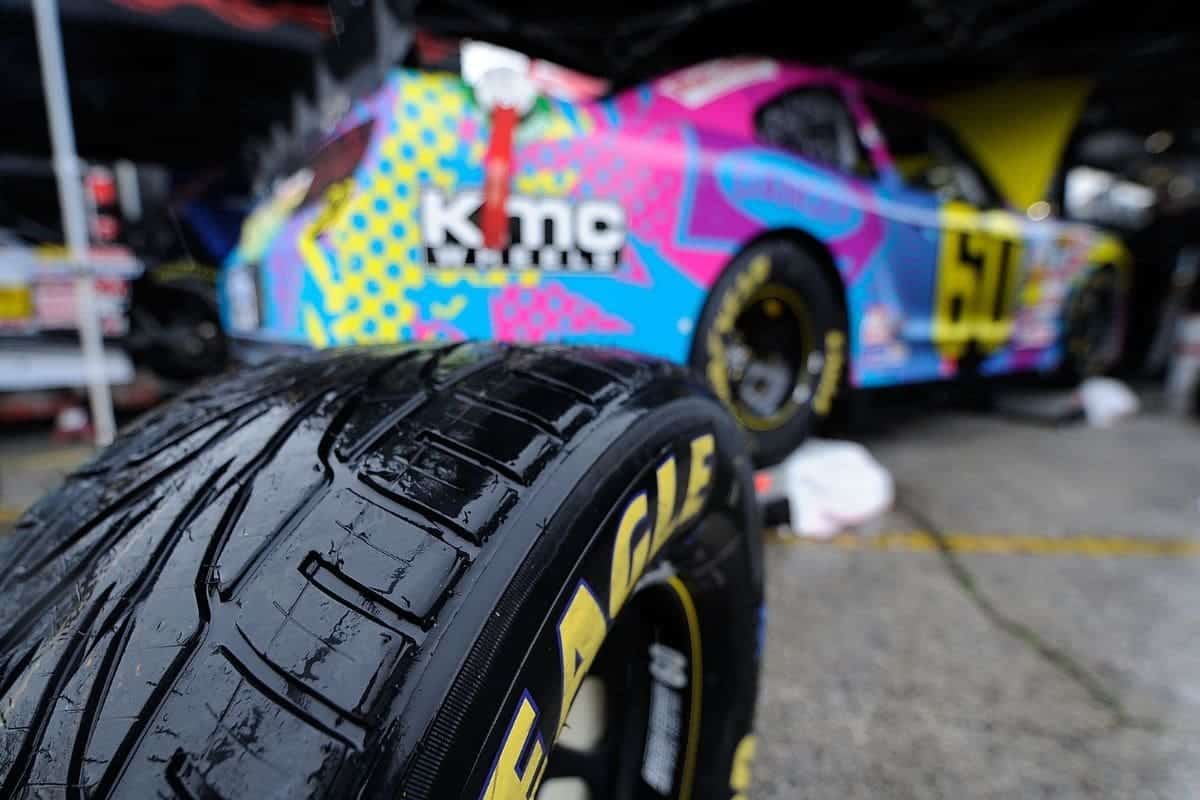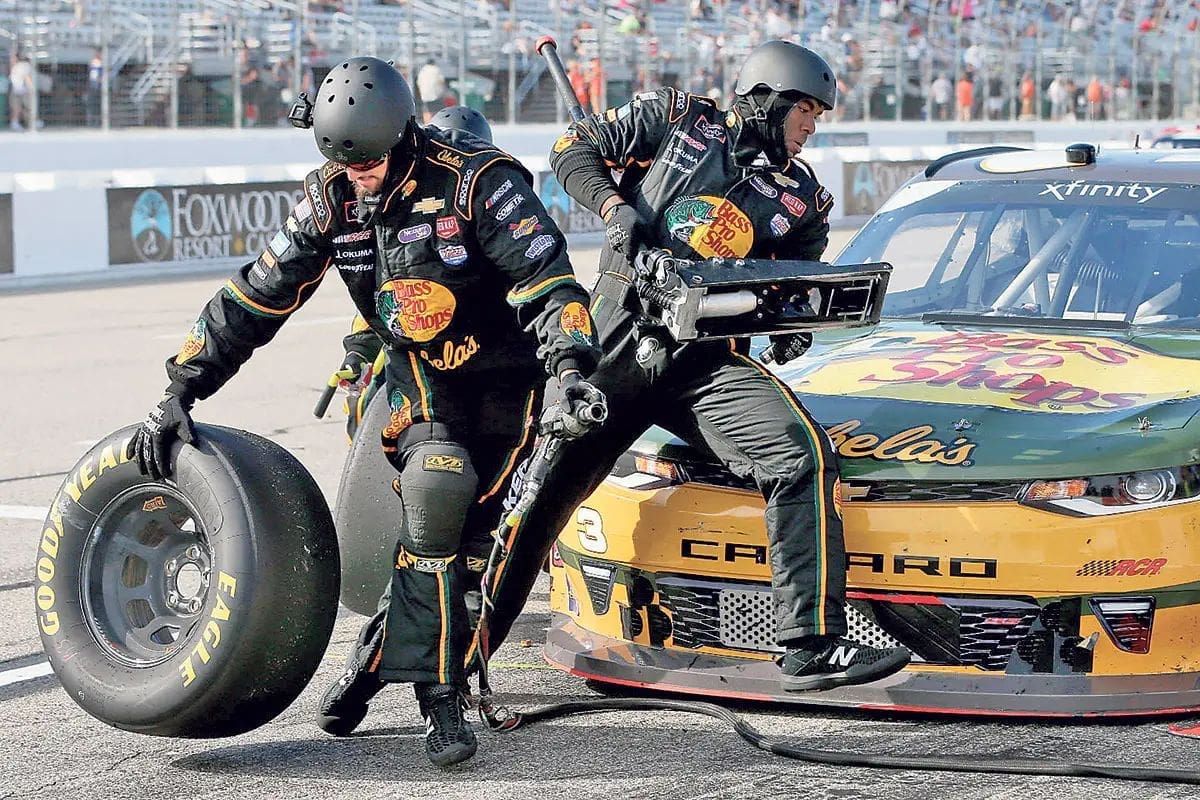NASCAR Dirt Experts Shine in New Hampshire: In a dramatic twist at New Hampshire Motor Speedway, the unforgiving rain turned the race into a proving ground for NASCAR’s dirt racing experts. Tyler Reddick, Kyle Larson, and Christopher Bell, all with deep roots in dirt track racing, navigated the treacherous conditions with exceptional skill and strategic tire management. Their ability to adapt highlighted the critical role of diverse racing backgrounds, raising questions about the future integration of wet weather strategies in NASCAR. As officials praised their performance, the broader implications for the sport’s evolution began to take shape, hinting at intriguing developments on the horizon.
Key Highlights
- Drivers with dirt racing backgrounds, like Reddick, Larson, and Bell, excelled using wet weather tires at NHMS.
- Wet weather tires added strategic depth, benefiting drivers skilled in tire management.
- NASCAR’s use of wet weather tires at NHMS was a resounding success, keeping all 301 laps exciting.
- Positive feedback from drivers and officials highlighted the successful integration of wet weather tires.
- The race showcased NASCAR’s adaptability and proactive approach to adverse weather conditions.
NASCAR’s Wet Weather Tires Success at NHMS
NASCAR’s strategic implementation of wet weather tires during the rain-delayed restart at New Hampshire Motor Speedway proved to be a game-changer, ensuring the completion of all 301 laps and reviving the excitement for all the drivers and fans. This crucial decision not only salvaged the race day but also demonstrated a level of adaptability that highlighted NASCAR’s commitment to competition integrity and viewer satisfaction.
The introduction of wet weather tires was met with widespread approval from teams and drivers, particularly those with dirt racing backgrounds. These drivers, skilled at managing tricky surfaces, found themselves in familiar territory, evocative of their experiences at Bristol. This familiarity allowed them to showcase their skills in tire management and vehicle control, adding competitive intrigue to the event.
Goodyear, often a controversial figure in NASCAR’s tire history, emerged as an unexpected hero in this scenario. Their wet weather tires performed exceptionally well under the challenging conditions, providing the necessary grip and durability to keep the race going. This shift in perception from a past villain to a present-day savior shows the importance of innovation and reliability in motorsport tire technology.
For the fans, the race was an enthralling spectacle. The unpredictability of the wet conditions combined with the skilled handling of the drivers created a captivating narrative that kept viewers on the edge of their seats. This accomplishment reaffirmed NASCAR’s position as a dynamic and resilient force in the world of motorsports.
History of Wet Weather Tires in NASCAR
Building upon the recent success at New Hampshire Motor Speedway, the use of wet weather tires in NASCAR has a rich history that reveals the evolution of the sport’s adaptability to varying track conditions. Wet weather tires, while now gaining prominence, have been part of NASCAR’s arsenal for decades, although with spontaneous application.
Initially developed for road courses where inclement weather often impacted races, these specialized tires have seen limited but strategic implementation on ovals and other track types. The story of wet weather tires in NASCAR began in the early 1990s. However, their use was restricted to road courses like Watkins Glen and Sonoma, where rain is a more frequent disruptor.
Fast forward to the 2020s, and NASCAR has expanded their application, particularly using them at Richmond earlier this season. This shift highlights the sport’s commitment to maintaining competitive racing under diverse weather conditions. At New Hampshire, the deployment of wet weather tires mid-race, particularly after a lengthy red flag, marked a significant milestone.
This was a pioneering moment, as it demonstrated NASCAR’s inventive approach to race management and the technical robustness of the tires themselves. The decision to introduce wet weather tires during an ongoing race was a calculated risk that paid off, facilitating a smoother continuation of the event despite challenging conditions.
Analysis by Jeff Gluck and Jordan Bianchi
In their latest episode of ‘The Teardown,’ Jeff Gluck and Jordan Bianchi provided an important analysis of the rain-soaked race at New Hampshire Motor Speedway, highlighting how wet weather conditions tested and demonstrated the drivers’ skills.
Gluck remarked, “But I also do want to say that these wet weather tires also happen to put on a great show. I mean, it’s a really compelling show because they open up all sorts of options.” His observation emphasizes the strategic depth introduced by these specialized tires, which allowed drivers to investigate varied racing lines in pursuit of top-notch grip.
Gluck’s analysis particularly spotlighted drivers like Tyler Reddick, Kyle Larson, and Christopher Bell, whose backgrounds in dirt racing gave them a distinctive advantage. These drivers adapted to the slippery conditions, leveraging their experience to drive the track effectively. Their ability to use different parts of the track to find the best lines mirrored the techniques honed in their dirt racing careers, a sign of their versatility and skill.
Jordan Bianchi added a vivid narrative dimension by highlighting a significant moment in the race. “Especially that restart with Bell? Yeah. When he was passing guys on the top side there, that was incredible to watch. Like that is the epitome of driver skill.” This not only illustrated Bell’s remarkable performance but also emphasized how the challenging conditions turned the race into a display of driving excellence.
This highlighted how the conditions showed off the drivers’ skills, making the race more exciting. Gluck agreed and said, “I love that, right?” to praise tire management. He also remembered the race at Bristol, where everyone had problems with high tire wear.
Reactions from Drivers and NASCAR Officials
Frequently hailed as a watershed moment for the sport, the race at New Hampshire Motor Speedway elicited a spectrum of reactions from drivers and NASCAR officials, who collectively praised the successful execution of a wet-weather event. With the race being the first of its kind, it was a significant test of adaptability and skill, particularly for those with dirt racing backgrounds.
Ricky Stenhouse Jr., who made an impressive climb from 24th to seventh, credited his dirt racing experience for his performance. Stenhouse Jr. emphasized that the conditions allowed drivers like him to shine, stating,
“It felt like a natural fit for us, even on pavement. The wet track brought out the skills we honed on dirt.”
Kyle Larson, who secured a fourth-place finish, echoed this sentiment with noticeable enthusiasm. “It was fun. I think that’s why you see a lot of the dirt racers kind of migrate to the front.” Larson remarked. He acknowledged that while it was a pavement race, the skills learned in dirt racing were invaluable, enabling drivers to handle the unique challenges posed by the wet surface.
Conversely, Chris Buescher of RFK Racing, who does not hail from a dirt racing background, offered a more measured response. “Oh ultimately yeah (it was a success). I mean we’ve finished our race. I think it worked.” Buescher commented, attributing the successful execution primarily to the efficacy of the wet-weather tires.
“They actually kept moisture in the track for a long period of time to where I think you would have seen the tire shine more in those conditions versus you know, all these cautions at the end, and us having to put three sets on to make sure that they weren’t blistering or really just peeling, but it worked. … We did pretty dang good and I’m not a dirt guy.” – (Buescher)
NASCAR officials, while not analyzing specifics, expressed their satisfaction with the race’s outcome. Their collective appreciation highlighted the collaborative effort that made this pioneering event possible, setting an example for future races under similar conditions.
Officials’ Praise and Future Implications
Reflecting on the race’s success, officials praised the groundbreaking use of wet-weather tires, seeing it as a pivotal moment that could redefine NASCAR’s approach to adverse conditions. Elton Sawyer, NASCAR’s Senior Vice President of Competition, expressed his elation over the decision, noting,
“Oh, we would have (had to call the race if we didn’t have wet-weather tires). We’d have been done with 82 laps ago… Kudos to our teams, our drivers, our owners, and especially Mr. (Jim) France for his vision.” – (Sawyer)
The implementation of wet-weather tires allowed the race to proceed safely, despite the challenging conditions. This strategic move not only kept the event exciting but also highlighted the drivers’ versatility, particularly those with dirt racing backgrounds. The conditions in New Hampshire, described as ‘Bellweather,’ emphasized NASCAR’s proactive stance in embracing new technologies to improve race day experiences.
Looking forward, the success of this initiative could have significant implications for future races. The ability to continue races under adverse weather conditions without sacrificing safety or entertainment value opens new avenues for scheduling and race management. This forward-thinking approach could potentially see an expansion in the use of wet-weather tires across more events, allowing NASCAR to maintain consistent race schedules even when faced with unpredictable weather patterns.
News in Brief: NASCAR Dirt Experts Shine in New Hampshire
The successful navigation of New Hampshire Motor Speedway’s adverse conditions by NASCAR’s dirt racing experts emphasizes the critical interplay between diverse racing backgrounds and tire management.
The performance of drivers such as Tyler Reddick, Kyle Larson, and Christopher Bell shows the strategic advantage offered by wet weather tires.
This event not only highlights the drivers’ adaptability but also signifies the potential for future advancements in tire technology and race strategy within NASCAR.
ALSO READ: NASCAR’s Wet Tire Drama: Delays and Explosive Reactions



